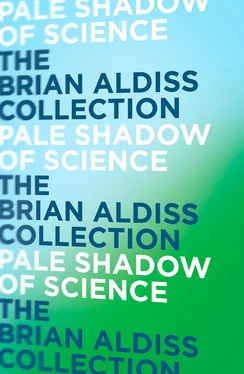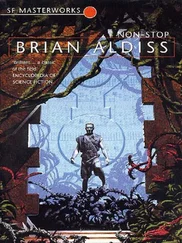Brian Aldiss - Pale Shadow of Science
Здесь есть возможность читать онлайн «Brian Aldiss - Pale Shadow of Science» — ознакомительный отрывок электронной книги совершенно бесплатно, а после прочтения отрывка купить полную версию. В некоторых случаях можно слушать аудио, скачать через торрент в формате fb2 и присутствует краткое содержание. Жанр: unrecognised, на английском языке. Описание произведения, (предисловие) а так же отзывы посетителей доступны на портале библиотеки ЛибКат.
- Название:Pale Shadow of Science
- Автор:
- Жанр:
- Год:неизвестен
- ISBN:нет данных
- Рейтинг книги:5 / 5. Голосов: 1
-
Избранное:Добавить в избранное
- Отзывы:
-
Ваша оценка:
- 100
- 1
- 2
- 3
- 4
- 5
Pale Shadow of Science: краткое содержание, описание и аннотация
Предлагаем к чтению аннотацию, описание, краткое содержание или предисловие (зависит от того, что написал сам автор книги «Pale Shadow of Science»). Если вы не нашли необходимую информацию о книге — напишите в комментариях, мы постараемся отыскать её.
Pale Shadow of Science — читать онлайн ознакомительный отрывок
Ниже представлен текст книги, разбитый по страницам. Система сохранения места последней прочитанной страницы, позволяет с удобством читать онлайн бесплатно книгу «Pale Shadow of Science», без необходимости каждый раз заново искать на чём Вы остановились. Поставьте закладку, и сможете в любой момент перейти на страницу, на которой закончили чтение.
Интервал:
Закладка:
A portrait of Mary Wollstonecraft by Sir John Opie shows a moody and passionate woman. Distracted by the failure of her love for Imlay, she tried to commit suicide by jumping into the Thames off Putney Bridge. She survived to marry Godwin and bear him a daughter, Mary. After the birth, puerperal fever set in, and she died ten days later.
Godwin remarried. His second wife was a Mrs. Mary Jane Clairmont, and she brought with her two children by her previous marriage, Charles, and Jane, who later preferred to be known as Claire and bore Byron an illegitimate child, Allegra. Fanny and Mary, then four years old, were further upset by the arrival of this new step-mother into their household, and the alienation was no doubt increased when Godwin’s new wife bore him a son in 1803. The five children crowded into one house increased Mary’s feeling of inner isolation, the refrain of which sounds throughout her novels and short stories. Another constant refrain, that of complex familial relationships, is seen embodied in the five children, no two of whom could muster two parents in common, Charles and Jane excepted.
Mary grew to be an attractive woman. [1]Her reserved manner hid deep feelings baffled by her mother’s death and her father’s distance – two kinds of coldness, one might say, both of which are embodied in her monster’s being in a sense dead and also unloved. When Shelley arrived, he received all her love, and Mary remained faithful to him long after his death, despite his callow unfaithfulness to her. She was also a blue stocking, the product of two intellectuals, and through many years maintained an energetic reading programme, teaching herself several foreign languages. Moreover, she had the good fortune to know in childhood many of the celebrated intellectuals and men of letters of the time, Samuel Taylor Coleridge among them. Trelawny said of Mary that ‘her head might be put upon the shoulders of a Philosopher.’
Enter Percy Bysshe Shelley, poet, son of a baronet. An emotional and narcissistic youth, full of admiration for Godwin’s revolutionary but now somewhat faded political theories. When nineteen, he had married Harriet Westerbrook. He soon fell in love with Mary, and she with him. Before his twenty-second birthday, the pair had eloped to France, taking Jane with them.
Europe! What freedom it must have represented to Mary, after her sixteen circumscribed years, and what close companionship Shelley, handsome and intellectual, must have offered. But these youthful travellers were among the first to enter France after the Napoleonic Wars, and a desolate place they found it, the fields uncultivated, the villages and buildings destroyed. On the way to Switzerland, Shelley wrote to invite Harriet, now pregnant with Shelley’s second child, to join the party. Before they reached Lake Lucerne, Mary knew that she also was pregnant.
Catastrophe followed the harum-scarum young lovers. Mary’s child, a daughter, was born after they returned to London and their debts; it was premature and died. A second child, William, scarcely fared better. In the summer of 1816, Shelley and Mary went to Switzerland again, taking along William and, inevitably, Claire, as Jane now called herself. On the shores of Lake Geneva, they found accommodation at the Maison Chapuis, next to the Villa Diodati, where the poet Lord Byron was staying. Although Claire threw herself at Byron’s head, and managed to encompass the rest of him too, it was a happily creative time for them, with philosophy and learning pursued as well as the more touted facets of the good life. Here, Mary began to write Frankenstein . Summer had too short a stay, and the party returned to England to face more trouble.
Mary’s self-effacing half-sister, Fanny, committed suicide with an overdose of laudanum at the age of twenty-two, by which time the Shelley menage had moved to the West Country; Claire still followed them, as the monster followed Frankenstein, and was now also pregnant. Then news reached them that Shelley’s wife Harriet had drowned herself, not in the Thames, but in the Serpentine. She had been far advanced in pregnancy. Shelley and Mary were married almost immediately.
The date of the marriage was 29 December 1816. Six and a half years later, in July 1822, Shelley was drowned whilst sailing on the Ligurian Sea. By that time, the little boy, William, was dead, as was another child, Clara; Mary had also had a miscarriage, but a further son, Percy Florence, was born. He alone of Mary’s progeny survived to manhood. Even Claire’s daughter by Byron, the little Allegra, had died.
The rest of Mary’s life is curiously empty, lived in the shadow of her first twenty-five years. After Byron died in Greece in 1824, both the great poets were gone – a loss to English letters. Mary remained ever faithful to the memory of her husband. She edited his poems and papers, and earned a living by her pen. She wrote historical novels, such as Perkin Warbeck (1830), Lodore (1835), which enjoyed some success, short stories, and one novel, The Last Man (1826) which, by its powerfully oppressive theme of world catastrophe, is classifiable as science fiction. Percy married. Her cold father, Godwin, died; Shelley’s difficult father died. Finally, in 1851, the year of the Great Exhibition, Mary herself died, aged fifty-three.
This painful biography, as confused as any modern one, is worth retelling, for it helps to explain not only why Mary’s temperament was not a sanguine one, but where much derives from what we read in her two science fiction novels, Frankenstein and The Last Man . Both owe a great deal to the literature that preceded them; more is owed to experience. Critics are liable comfortably to ignore the latter to concentrate on the former.
The essence of the story of Frankenstein is familiar, if in distorted form, from many film, stage and TV versions, in which Victor Frankenstein compiles a creature from corpses and then endows it with life, after which it runs amok. The novel is long, and more complex than this synopsis suggests. It is a flawed masterpiece of growing reputation, and an increasing body of criticism attests to the attraction of both its excellences and its flaws.
Frankenstein or, The Modern Prometheus begins with letters from Captain Walton to his sister. Walton is sailing in Arctic waters when he sees on the ice floes a sledge being driven by an enormous figure. The next day, the crew rescue a man from a similar sledge. It is Victor Frankenstein of Geneva; when he recovers, he tells his tale to Walton, which account makes up the bulk of the book, to be rounded off by Walton again, and to include six chapters which are the creature’s own account of its life, especially of its education. If the style of the novel is discursive, Mary Shelley was following methods familiar to readers of Richardson and Sterne; the method became unfashionable but, to readers of eccentric modern novels, may now be increasingly sympathetic and help to account in part for the new-found popularity of the novel.
One of the enduring attractions of the book is that Mary sets most of the drama, not in the seamy London she knew from childhood, but amid spectacular alpine scenery, such as she had visited with Shelley. The monster’s puissance gains greatly by this association with the elements, storm, cold, snow, desolation.
Interest has always centred on the monster and its creation (it has no name in the novel, merely being referred to as ‘creature,’ ‘daemon,’ or ‘monster,’ which accounts for the popular misusage by which the name Frankenstein has come to be transferred from the creator to the created – a mistake which occurred first in Mary’s lifetime. This is the essential SF core of the narrative: a fascinating experiment that goes wrong: a prescription to be repeated later, many times, in Amazing Stories and elsewhere. Frankenstein’s is a Faustian dream of unlimited power, but this Faust makes no supernatural pacts; he succeeds only when he throws away the fusty old reference books, outdated by the new science, and gets to work on research in laboratories.
Читать дальшеИнтервал:
Закладка:
Похожие книги на «Pale Shadow of Science»
Представляем Вашему вниманию похожие книги на «Pale Shadow of Science» списком для выбора. Мы отобрали схожую по названию и смыслу литературу в надежде предоставить читателям больше вариантов отыскать новые, интересные, ещё непрочитанные произведения.
Обсуждение, отзывы о книге «Pale Shadow of Science» и просто собственные мнения читателей. Оставьте ваши комментарии, напишите, что Вы думаете о произведении, его смысле или главных героях. Укажите что конкретно понравилось, а что нет, и почему Вы так считаете.










